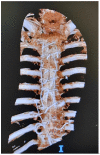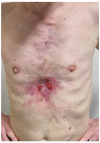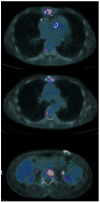Multidisciplinary Management of Sternal Osteomyelitis Due to Klebsiella aerogenes after Open Heart Surgery in a Patient with Multiple Myeloma: A Case Report and Discussion of the Literature
- PMID: 38004712
- PMCID: PMC10673517
- DOI: 10.3390/microorganisms11112699
Multidisciplinary Management of Sternal Osteomyelitis Due to Klebsiella aerogenes after Open Heart Surgery in a Patient with Multiple Myeloma: A Case Report and Discussion of the Literature
Abstract
Sternal wound complications following cardiac surgery, including sternal dehiscence, mediastinitis, and osteomyelitis, pose significant challenges in terms of management and patient outcomes. We present a case report highlighting the complex management of a patient who underwent open heart surgery for severe aortic valve stenosis, followed by sternal wound dehiscence and sternum osteomyelitis due to extended spectrum beta lactamase (ESBL) producing Klebsiella aerogenes. A multiple myeloma diagnosis was also suspected at the positron emission tomography (PET) scan and confirmed with bone marrow biopsy. Multidisciplinary evaluation of the case led to a comprehensive treatment plan. To control the sternal osteomyelitis, total sternectomy was performed followed by immediate reconstruction with a bone (tibia) graft from the tissue bank and fixation with the minimal hardware possible. A microsurgical latissimus dorsi free flap was required to reconstruct the soft tissue defect. After 6 weeks of antibiotic treatment with ertapenem and fosfomycin based on a culture of intraoperative material, no clinical, imaging, or laboratory signs of infection were seen. Multiple myeloma treatment was then started. At 1 year of follow up, no recurrence of infection occurred, and the reconstruction was stable and closed. Multiple myeloma is under chronic treatment with novel agent combination, with an excellent haematological response.
Keywords: chest reconstruction; microsurgical flap; multiple myeloma; open heart surgery; sternal osteomyelitis.
Conflict of interest statement
The authors declare no conflict of interest.
Figures







Similar articles
-
Sternal osteomyelitis: use of vacuum-assisted closure device as an adjunct to definitive closure with sternectomy and muscle flap reconstruction.J Card Surg. 2004 Sep-Oct;19(5):453-61. doi: 10.1111/j.0886-0440.2004.05002.x. J Card Surg. 2004. PMID: 15383060
-
[Transplantation of allogeneic bone graft in the therapy of massive post-sternotomy defects - 6 years of experience with the method].Rozhl Chir. 2016 Fall;95(11):399-406. Rozhl Chir. 2016. PMID: 28033018 Czech.
-
[Plastic Reconstruction with a Vascular Pedicle Latissimus Dorsi Flap after Sternal Osteomyelitis].Zentralbl Chir. 2017 Oct;142(5):451-454. doi: 10.1055/s-0042-102657. Epub 2016 Jun 13. Zentralbl Chir. 2017. PMID: 27294603 German.
-
[A case of successful treatment of chronic sternal osteomyelitis and mediastinitis after ascending aorta and hemiarch reconstruction].Kyobu Geka. 1995 Jun;48(6):495-8. Kyobu Geka. 1995. PMID: 7602866 Review. Japanese.
-
Sternal reconstruction after post-sternotomy mediastinitis.J Cardiothorac Surg. 2017 Nov 2;12(1):94. doi: 10.1186/s13019-017-0656-7. J Cardiothorac Surg. 2017. PMID: 29096673 Free PMC article. Review.
Cited by
-
Diagnosis of Prosthetic Endocarditis Caused by Coxiella burnetii Using PET Scan and PCR: A Case Report of Chronic Q Fever.Clin Case Rep. 2025 Mar 5;13(3):e70289. doi: 10.1002/ccr3.70289. eCollection 2025 Mar. Clin Case Rep. 2025. PMID: 40051899 Free PMC article.
-
Infectious Costochondritis With Sternal Osteomyelitis.Cureus. 2025 Mar 6;17(3):e80132. doi: 10.7759/cureus.80132. eCollection 2025 Mar. Cureus. 2025. PMID: 40190880 Free PMC article.
-
Emerging Concepts for the Treatment of Biofilm-Associated Bone and Joint Infections with IV Fosfomycin: A Literature Review.Microorganisms. 2025 Apr 23;13(5):963. doi: 10.3390/microorganisms13050963. Microorganisms. 2025. PMID: 40431135 Free PMC article. Review.
References
Publication types
LinkOut - more resources
Full Text Sources

